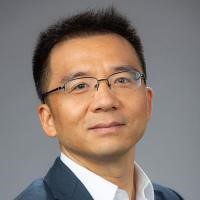
Upcoming Lectures

Upcoming Lectures
Lecture 4 Acoustofluidics: merging acoustics and microfluidics for biomedical applications
声流控:应用于生物医学的“隔山打牛”技术
日期: 2022-11-15 点击:
Speaker Bio

Tony Jun Huang is the William Bevan Distinguished Professor of Mechanical Engineering and Materials Science at Duke University. Previously he was a professor and the Huck Distinguished Chair in Bioengineering Science and Mechanics at The Pennsylvania State University. He received his Ph.D. degree in Mechanical and Aerospace Engineering from the University of California, Los Angeles (UCLA) in 2005. His research interests are in the fields of acoustofluidics, optofluidics, and micro/nano systems for biomedical diagnostics and therapeutics. He has authored/co-authored over 260 peer-reviewed journal publications in these fields. His journal articles have been cited more than 26,000 times, as documented at Google Scholar (h-index: 87). He also has 26 issued or pending patents. Prof. Huang was elected a fellow (member) of National Academy of Inventers (USA) and the European Academy of Sciences and Arts. He was also a fellow of the following six professional societies: American Association for the Advancement of Science (AAAS), the American Institute for Medical and Biological Engineering (AIMBE), the American Society of Mechanical Engineers (ASME), the Institute of Electrical and Electronics Engineers (IEEE), the Institute of Physics (UK), and the Royal Society of Chemistry (UK). In addition, he has selected to receive many prestigious awards and honors including a 2010 National Institutes of Health (NIH) Director’s New Innovator Award, a 2012 Outstanding Young Manufacturing Engineer Award from the Society for Manufacturing Engineering, the 2014 IEEE Sensors Council Technical Achievement Award from the Institute of Electrical and Electronics Engineers (IEEE), the 2017 Analytical Chemistry Young Innovator Award from the American Chemical Society (ACS), the 2019 Van Mow Medal from the American Society of Mechanical Engineers (ASME), and the 2019 Technical Achievement Award from the IEEE Engineering in Medicine and Biology Society (EMBS).
黄俊(Tony Jun Huang)博士是美国杜克大学机械工程与材料科学系William Bevan杰出讲席教授。此前,他是宾州州立大学生物工程科学与力学系的Huck杰出讲席教授。2005年在加州大学洛杉矶分校机械与航空工程系获得博士学位。他的研究兴趣在声流控、光流控、和微/纳系统在生物医药诊断和治疗领域的应用研究。到目前为止,他在这些领域发表了超过260篇国际期刊论文。他的期刊论文总引用次数超过26000次,谷歌H因子达到87。并且,他还拥有26项授权/在审专利。他已被选为以下六个国际专业学会的会士 (Fellow):美国科学促进会(AAAS)、美国医学和生物工程学会(AIMBE)、美国机械工程师协会(ASME)、国际电气和电子工程师协会(IEEE)、英国物理学会(IOP)、英国皇家化学学会(RSC)。同时,他的研究也获得了诸多的奖项和荣誉,其中包括2010年美国国立卫生研究院(NIH)青年创新奖,2012年国际制造工程学会杰出青年制造工程师奖,2013年美国哮喘基金会(AAF)学者奖,2011、2013、2016年JALA年度最佳十大突破奖,2014年国际电气和电子工程师协会(IEEE)的传感器理事会技术成就奖(IEEE),2017年美国化学学会(ACS)分析化学青年创新奖,2019年美国机械工程师协会(ASME)Van Mow奖章和2019年IEEE EMBS技术成就奖。2020年他当选美国国家发明家科学院(National Academy of Inventors)院士。2022年他当选欧洲科学和艺术院(European Academy of Sciences and Arts)院士。
Abstract
The use of sound has a long history in medicine. Dating back to 350 BC, the ancient Greek physician Hippocrates, regarded as “the father of medicine”, devised a diagnostic method for detecting fluid in the lungs by shaking patients by their shoulders and listening to the resulting sounds emanating from their chest. As acoustic technology has advanced, so too has our ability to “listen” to the body and better understand underlying pathologies. The 18th century invention of the stethoscope allowed doctors to gauge the health of the heart; the 20th century invention of ultrasound imaging revolutionized the field of biomedical imaging and enabled doctors to diagnose a range of conditions in the fields of obstetrics, emergency medicine, cardiology, and pulmonology. In the last decade, a new frontier in biomedical acoustic technologies has emerged, termed acoustofluidics, which joins cutting-edge innovations in acoustics with micro- and nano- scale fluid mechanics. Advances in acoustofluidics have enabled unprecedented abilities in the early detection of cancer, the non-invasive monitoring of prenatal health, the diagnoses of traumatic brain injury and neurodegenerative diseases, and have also been applied to develop improved therapeutic approaches for transfusions and immunotherapies. In this talk, I summarize our lab’s recent progress in this exciting field and highlight the versatility of acoustofluidic tools for biomedical applications through many unique examples, ranging from the development of high-purity, high-yield methods for the separation of circulating biomarkers such as exosomes and circulating tumor cells, to highly precise, biocompatible platforms for manipulating cells and studying cell-cell communication, to high-throughput therapeutic approaches for platelet isolation and enrichment, to strategies for high-resolution 3D bioprinting, to programable, contact-free technologies for digital fluid manipulation. These acoustofluidic devices can precisely manipulate objects across 7 orders of magnitude (from a few nanometers to a few centimeters). Thanks to these favorable attributes (e.g., versatility, precision, and biocompatibility), acoustofluidic devices harbor enormous potential in becoming a leading technology for a broad range of applications, playing a critical role for translating innovations in technology into advances in biology and medicine.
过去二十余年我们见证了芯片实验室技术及其应用在生物学、化学和医学领域的爆炸式发展。各种不同的物理新特性与微流控技术不断融合,为这一领域的快速发展提供了源源不竭的动力。最近,一种融合了微纳制造和表征技术,声学技术和微流体控制技术的新型芯片实验室前沿技术逐渐兴起,这就是声流控,也可以叫作声学镊子。这一技术不需要直接接触目标,就可以“隔山打牛”般地对细胞或更小的生物粒子进行精准地操控。我们的研究团队从2009年便开始聚焦声流控技术的操作原理和在生物医学领域的应用,在这个令人兴奋的领域取得了一些进展。相较于传统的光学镊子,声学镊子不需要依靠高能激光,能量密度较低,而且具有非常广的适用范围,尺度可以横跨纳米到毫米级别,对介质和作用对象种类没有特定的选择性,可以用于多种环境。例如,我们不仅实现了利用声学镊子操控20纳米的粒子,还可以精确地三维旋转移动毫米级别的秀丽隐杆线虫。另外,声流控技术是一种非常安全的技术,可以最大限度保持生物样本的自然状态,具有极强的生物兼容性,因此大幅提高检测的精度,同时依据应用情景不同,提供从低通量到高通量的多种实现选择。经过十年的研究和发展,声流控技术已经渗透和应用到了多个生物医学领域,展示了巨大的发展潜力。我们开发的基于声流体的分离技术,不仅可以分离微米级的循环肿瘤细胞和细菌,还可以从多种生物液中分离纳米尺度的细胞外泌体。相较于传统的分离技术,我们大幅提高了通量和分离纯度,同时缩短了时间,并几乎完整的保留了生物样本的活性。我们还将声流控技术用于细胞分选和单细胞操控,基于声流控的荧光激活细胞分选技术仅仅使用手机大小的器件就可以实现超高通量的细胞分选,同时最大限度保留了细胞活性;声学镊子不仅可以精确操纵单个或者单对细胞,控制它们之间的距离、接触和分离,还可以同时高通量可编程地操纵多对细胞,为体外研究大量不同细胞间的相互作用提供了途径。在高通量操控单细胞的基础上,三维声学镊子可以在衬底的特定位置接种不同细胞,进而以特定的形状组装细胞,实现2D或者3D的组织工程和生物打印。声流控技术还可以用来操控液滴的运输、融合、混匀、分裂和级联反应,为数字微流体提供了全新的方案。声流控技术目前还处于发展的初期,有着巨大的研究和探索空间,我们期待做出更多的工作。


